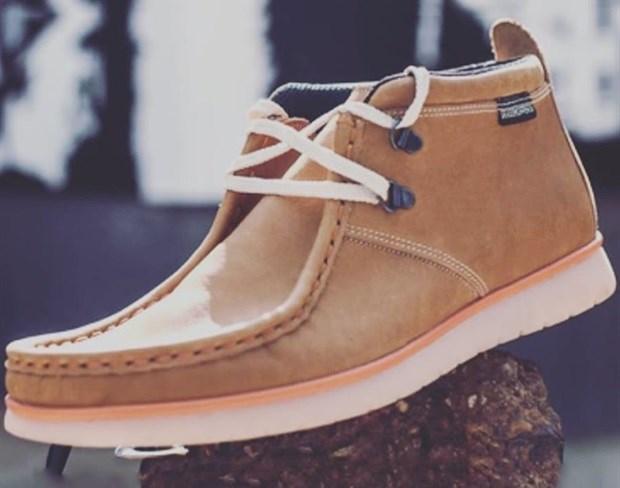
Grasshoppers are designed to be worn for long stretches of time, and the company's promise of delivering "the most comfortable shoe ever made" has seen its product worn everywhere from the school playground and the office, to the factory floor, casual social gatherings and weddings.
Perhaps most admirable is that these iconic South African shoes are still painstakingly crafted using time-honoured shoemaking techniques at the original production facility in Great Brak River in the Southern Cape. More than 20 million shoes have left the factory to date, with around 750,000 hand-finished Grasshoppers produced every year.
The factory, both directly and indirectly, employs some 1,000 local craftsmen – some of whom are third generation artisans – living in Great Brak and the surrounding Southern Cape area.
The history of Grasshoppers dates back to 1859, when a toll-gate was established at Great Brak River to toll the ox wagons transporting goods between Cape Town and Port Elizabeth. The transporters walked the 800km next to the oxen and did not ride on the goods-laden wagons. The tollkeepers noticed that these people wore through their shoes quite quickly and hence started a shoe and boot factory in the village.
By 1890, it was a formal factory registered with the Cape government and soon became known nationally. Many brands have been manufactured there over the years, but Grasshoppers has been the most successful.

It's no small feat for a local footwear business to not only survive, but thrive, in a tough manufacturing climate. Now forming part of the Bolton Footwear stable, the Grasshoppers brand may be as relevant today as is ever was, its shoes becoming known as somewhat of a street style staple among the millennial crowd. While traditionally popular among men, its female fanbase is growing too.
Perhaps the company is dead on then in its belief that if they can get a pair of Grasshoppers on somebody's feet, they'll wear them forever.
Here, Grasshoppers CEO Alan Fleetwood shares the history of the brand, its artisanal approach to shoemaking and the fruitful relationship forged between the original Grasshoppers factory and its surrounding Southern Cape community.
The Grasshoppers brand was launched in 1966 and the 20millionth pair came off the production line recently. Its success is simple to understand - it is the most comfortable shoe ever made. Grasshoppers have always been made according to shoemaking constructions that ensure great comfort and using materials of trusted quality, handmade by highly-skilled people to exacting standards.
The construction types include California, Moccasin and Stitchdown. These are very specialised construction methods and not many factories around the world can do them well. There are specialised designers who ensure that Grasshoppers remains comfortably fashionable through all age groups.

The unique materials that are used in Grasshoppers – such as full grain leathers, pure crepe rubber soles, special high-quality threads used in the handlacing of the moccasins – are of a nature that the people who work with these materials make decisions continuously throughout their handling of them. The performance of a purely machine-made shoe will not stand up to what human eyes can ensure a pair of Grasshoppers offers.
Since around 1859, the village arose because of shoe manufacturing. So the area needs the factory and the factory equally needs the people. It is a symbiotic relationship. We support education in the village by sponsoring teacher posts so as to improve the teacher-pupil ratio, and we offer some tertiary bursaries to all youngsters in the village to get them going on their academic road.

In the late 1990s, the greater part of the factory was divided into mini-businesses and given to separate groups of workers who organised themselves into several sustainable business units. Today, there are 13 of these self-sufficient businesses supplying Bolton Footwear. The success of this true empowerment action, long before BEE was enforced, can be measured in the doubling of footwear volumes from that time to the present.
With assistance from the DTI, a Footwear Cluster was established in the village. This provides training and working opportunity for interns, most of whom have succeeded and entered full-time employment with the company. There is also a successful training school where school-leavers are taught manufacturing skills and are equipped to offer their skills to employers other than just the company itself.
Today there are 160,000 clothing, textile and footwear SA jobs being held by Chinese workers in China for goods imported into our country that were previously made, and still could be made, here. In SA, 260-million pairs of shoes are consumed annually and only 60-million are manufactured in SA.
I'm sure SA retailers have made the connection that the more they imports at the expense of SA manufacturing, the fewer consumers they will eventually have, as their customers become jobless and stop consuming. It is a very sad phenomenon and the recent closures of two very large footwear factories have taken about 4,200 consumers out of the economy.
Grasshoppers survives because it offers relevant footwear of unique construction at excellent value for money. Sizeable volumes also provide an economy of scale which allows value over Chinese imports. The company also manufactures many other brands such as Crockett & Jones, Barker, Watson, Step-on-Airs, Bronx and manufactures under house-brands for chains.
The continuous growth of Grasshoppers happens because the brand fulfills on its promise of appropriate fashion with value for money and unbeatable comfort. Thus, it appeals to people of all ages who can identify with a good shoe. Customers who are exposed to the brand from a young age, remain loyal throughout their lives.

We continue to bring comfortable fashionability into the design of the shoe. We research changing podiatry trends and adapt accordingly. Importantly, we are ensuring the availability of the shoes on our stockists' shelves at all times so that it is available when the consumer needs it.
We will never compromise on ensuring that Grasshoppers are the most comfortable shoes ever made.
